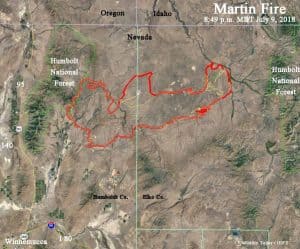
Folks quoted: Nevada State Wildlife specialists.
Worseness due to fires: reduction in habitat of threatened species and other habitat.
Future problems: non-native grasses change fire behavior AND are poor habitat. What to do? Here are some ideas.
I think it’s interesting (I think we’ve seen it before) that you can still hunt species that are threatened, and have massive efforts by ranchers and feds on the habitat side.
The agency says the fire that started in Paradise Valley north of Winnemucca burned 689 square miles of mostly rangeland — the largest fire in Nevada history. Visible from a NASA satellite, it came on the heels of another wildfire last year that burned 267 square miles north of Battle Mountain.
“This fire negatively affected one of the few remaining stronghold habitats for greater sage-grouse and a myriad of other sagebrush obligate species in Nevada,” said Shawn Espinosa, an upland game staff specialist for the state agency.
“Although we have hopes that restoration efforts can be successful, there will be some areas that will likely convert to cheatgrass which will further reduce available habitat for sage-grouse into the future.”
Hunting units 051 and 066 will remain closed for sage grouse until further notice along the Idaho line from McDermitt in the west to Owyhee in the east and as far south as just west of Battle Mountain.
Another fire burning about 15 miles (north of Battle Mountain has charred more than 60 square miles.
Greater sage grouse, a ground-dwelling bird about the size of a chicken, once numbered in the millions across much of the West, but the U.S. Fish and Wildlife Service now estimates the population at 200,000-500,000.
Experts blame energy development, along with wildfires, disease and livestock grazing.
Their range covers parts of 11 Western states and two Canadian provinces.
State wildlife officials say the two big Nevada fires not only burned grouse breeding sites but also destroyed priority winter habitat which will likely affect he bird’s annual production and survival rates.
No other states have implemented grouse hunting restrictions as a result of fires. Wildlife biologists have said in the past that hunting doesn’t generally threaten the survival of sage grouse populations.
Here’s another interesting story about innovative tactics used on the Martin fire from Wildfire Today here, and using non-native grasses for fuel treatments.
Yesterday, fire spread slowed significantly due to the hard work of the local Elko Task Force that hit the head of the fire early Sunday morning and throughout the day. The task force took advantage of the fire naturally slowing as it entered flatter terrain with lesser fuel loads. Operations personnel report that the fire is moving into patches of greener vegetation such as Siberian wheat grass, which was planted as part of the BLM’s rehabilitation and fuel treatment efforts on previous fires. Green fuels slow the fire’s advance, making it easier for bulldozers and engines, with the aggressive assistance of super scooper air tankers and heavy and light helicopters, to catch up and get containment lines in place.
“Although we have hopes that restoration efforts can be successful, there will be some areas that will likely convert to cheatgrass which will further reduce available habitat for sage-grouse into the future.”
====
But whatever happened to the “just leave nature alone and let it restore itself” mandate ??? I know that the saying has mainly been applied to forests, but is this faith affirmation not also applied to all plant ecosystems ??? Now I’m also curious about this statement:
“Experts blame energy development, along with wildfires, disease and livestock grazing.”
Does the part about “Experts blame energy development,” also include massive hectares of Solar Farms and Wind Turbine complexes which have ruined wildlife habitat ??? I mean you know, aside from the usual energy targets ???
By far, the Martin Fire has been the largest wildfire this year to date. It burned 435,569 acres of grass and brush and essentially zero “forests” of any kind. This wildfire currently accounts for 7% of the entire burned acres in all 50 states.
But, you know…more logging…”environmental terrorists groups”….”environmental extremists.”
What’s different with range fires is that cheatgrass is an aggressive invasive species that will completely modify the ecosystem following fire, so nature can’t “restore itself.” I don’t think there is anything quite like it in most forested ecosystems.
Here’s the part of the 2015 summary by the Fish and Wildlife Service of why they did not list greater sage-grouse that relates to energy: “Advancements in oil and gas technologies have reduced the anticipated footprint of future development; … and renewable energy development, although still a potential, is unlikely to occur in areas where greater sage-grouse occur in the highest densities.”